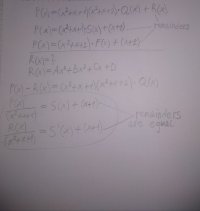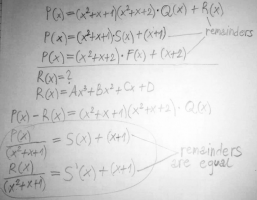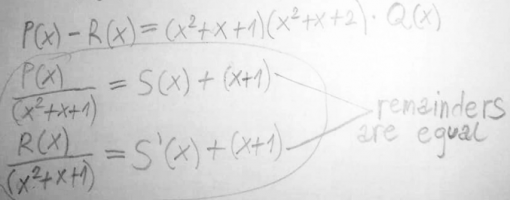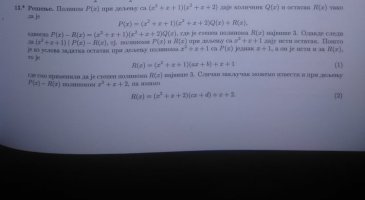I did some OCR and Google translation on the solution you provided; it's obviously not perfect, but here it is:
13. * Decision. The polynomial P(x) when divided by (x^2 + x + 1) (x^2 + x + 2) gives the quotient Q(x) and the remainder R(x) so that
P(x) = (x^2 + x + 1)(x^2 + x + 2) Q(x) + R(x),
that is, P(x) - R(x) = (x^2 + x + 1)(x^2 + x + 2) Q(x), where the degree of the polynomial R(x) is at most 3.
Hence yes (x^2 + x + 1) | P(x) - R(x), i.e. the polynomials P(x) and R(x) when divided by x^2 + x + 1 give the same remainder.
Since from the condition of the problem, the remainder when dividing the polynomial x^2 + x + 1 by P(x) is equal to x + 1, and it is the same for R(x), it is
R(x) = (x^2 + x + 1) (ax + b) + x + 1 (1)
where we have applied that the degree of the polynomial R(x) is at most 3. A similar conclusion can be reported when dividing P(x) - R(x) polynomial x^2 + x + 2, so we have
R(x) = (x^2 + x + 2) (cx + d) + x + 2. (2)
From (1) and (2) we find
(x^2 + x + 1) (ax + b) + x + 1 = (x^2 + x + 2) (cx + d) + x + 2,
and hence from the equality of two polynomials follows a = c = 0, b = d = -1. If a = 0 and b = -1 we replace in (1) we obtain the required remainder R(x) = -x^2.
This is what I have been waiting for: the details of what it says, rather than little excerpts or paraphrases. I am no longer blind.
I put the key part in bold: the claim you are asking about, together with what it says implies that.
The statement that P(x) - R(x) = (x^2 + x + 1)(x^2 + x + 2) Q(x) means that the difference between the given polynomial P(x) and its remainder R(x) is a multiple of (x^2 + x + 1), and
any two polynomials that differ by a multiple of the divisor must have the same remainder. Yes, this should be obvious; but I don't know what you have been taught from which it should be obvious!
If you had learned any number theory, which I assume you have not (though they use the symbol for divisibility, which is used there), this is a basic idea in modular congruence. This is what I was talking about in my first answer:
In this example, 45 = 13*3 + 6, and 97 = 13*7 + 6; the difference between 45 and 97 is 97 - 45 = (13*7 + 6) - (13*3 + 6) = 13(7 - 4) = 13*3 = 39. If they had different remainders, then the difference could not be a multiple of 13.
The same is true for polynomials. Suppose that P(x) = (x^2 + x + 1)q(x) + r(x), so that its quotient is q with remainder r; and R(x) = (x^2 + x + 1)q'(x) + r'(x), with quotient q' and remainder r'. (Both remainders must have degree less than 2.) Then
P(x) - R(x) = [(x^2 + x + 1)q(x) + r(x)] - [(x^2 + x + 1)q'(x) + r'(x)] = (x^2 + x + 1)[q(x) - q'(x)] + [r(x) - r'(x)]
But since we know P(x) - R(x) is a multiple of (x^2 + x + 1), we can conclude that r(x) - r'(x) = 0. Do you see that? So the two remainders must be the same.
As I've said, the degree is not the central issue; I think you have been distracted by that. The fact that the degree of R(x) is at most 3
is not a condition of the fact you are asking about! It is used later. The equality of the two remainders follows
only from the divisibility of the difference, which is the last thing that had been mentioned.
Can you see why I have been begging to see the entire solution you were asking about? It is quite common that students don't give us everything we need, because they don't understand how important the entire context can be to communication. The added difficulty of language differences makes this harder, but it doesn't make it any less necessary.
There's a good chance that you still have questions, so ask them. I'll keep working at it, because I'm stubborn.






